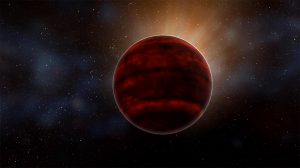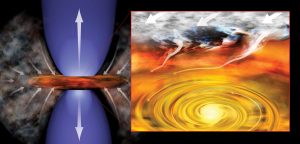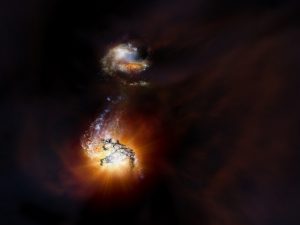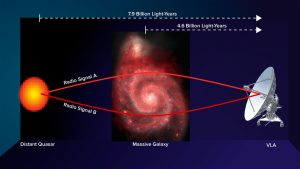This artist’s concept shows two proplyds, or protostars, around a massive O-type star. The nearer proplyd is having its planet-forming dust and gas blasted away by the radiation from the star. The farther proplyd is able to retain its planet-making potential.


Powerful Flare from Star Proxima Centauri Detected with ALMA
Artist impression of a red dwarf star like Proxima Centauri, the nearest star to our sun. New analysis of ALMA observations reveal that Proxima Centauri emitted a powerful flare that would have created inhospitable conditions for planets in that system.

Primordial Galaxies Swimming in Vast Ocean of Dark Matter
Artist impression of a pair of galaxies from the very early universe. Ongoing observations with the Atacama Large Millimeter/submillimeter Array (ALMA) have discovered surprising examples of massive, star-filled galaxies seen when the cosmos was less than a billion years old. This suggests that smaller galactic building blocks were able to assemble into large galaxies quite quickly. The latest ALMA observations push back this epoch of massive-galaxy formation even further by identifying two giant galaxies seen when the universe was only 780 million years old, or about 5 percent its current age. ALMA also revealed that these uncommonly large galaxies are nestled inside an even-more-massive cosmic structure, a halo of dark matter several trillion times more massive than the sun.

Outflows from a Young Solar System
Infant stars, like those recently identified near the supermassive black hole at the center of our galaxy, are surrounded by a swirling disk of dust and gas. In this artist’s conception of an infant solar system, the young star pulls material from its surroundings into a rotating disk (right) and generates outflowing jets of material (left).

A Starbursting Merger in the Early Universe
Artist impression of two starbursting galaxies beginning to merge in the early universe.

Measuring Magnetic Fields
Artist’s conception of gravitational lens arrangement that allowed astronomers to measure a galaxy’s magnetic field. Magnetic fields affect radio waves that travel through them. Analysis of the VLA images showed a significant difference between the two gravitationally-lensed images in how the waves’ polarization was changed. That means, the scientists said, that the different regions in the intervening galaxy affected the waves differently.





